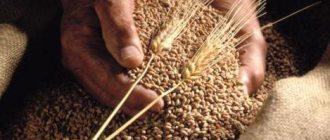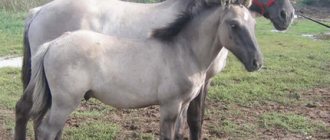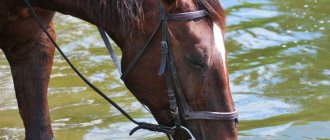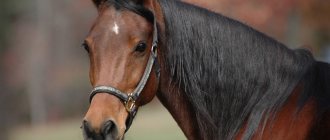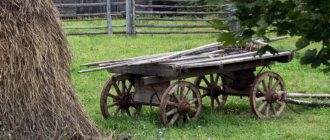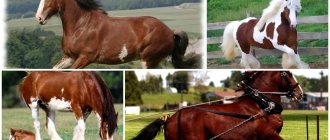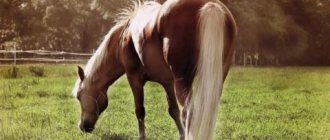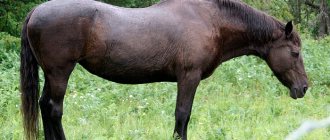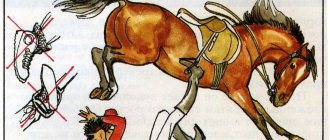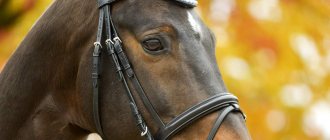Horse management
The conditions in which a horse lives clearly affect its health, behavior and capabilities, not to mention its life expectancy.
A well-groomed animal will live a long and happy life.
Stable
Horses can be kept in one of three systems: a stall, a stall, or use group housing.
The stall involves a separate room for each horse. This type of housing came to us from America - horses are kept there only in this way. The stall area is much easier to clean, and there is also a lot of free space. But when creating a stall, you need to take proper care of its layout, otherwise the animal may feel lonely, isolated from the rest.
A horse left alone will show aggression, refuse to eat, and lose a lot of strength. To prevent this from happening, when creating a stall, you need to take care of the bars or at least the windows between them. They need to be installed in such a way that the horses can observe each other.
Stalls in the stables
A stall is the most budget option. It has one drawback - cleaning it, which will be much more difficult. But there are also advantages. For example, all the horses will stick together, they will not feel lonely, they will be able to communicate with each other. The stall is also much more economical, both financially and in terms of saving space.
Horses in stalls
Group housing is used mainly for housing working individuals of approximately the same age. Each section can contain from 25 to 90 animals
It is important to plan this space so that the horses are free, they must be able to move around the space allocated for them. Group housing is most often used for low value breeds.
This system has one big disadvantage - cleaning the room, which is extremely inconvenient to do. The main advantage of group housing is the ability of animals to move, some freedom. For example, they will be able to play with each other or develop their limbs.
Room for group keeping of horses
The last two types of content are suitable mainly for warm days. In the cold season, a stall will be the best option, since you can easily remove it. This also applies to the period of viral infections. In winter, it is impossible to ventilate the premises, as horses require warmth. However, when kept in a stall, animals will be additionally protected from infections thanks to partitions.
Regarding the stable itself, there must be at least four square meters per individual to make it comfortable. The room should have a large number of windows, since a lack of light can not only deprive the animal of good vision, but also negatively affect its general condition. A ventilation system must be organized under the roof to prevent drafts.
The stable should be light and spacious
Grazing
Each horse should be given time to roam freely. It is impossible to say the exact amount of time that horses need to spend in the fresh air - here you can use the rule “the more, the better.” But walking is not about using the horse's strength or testing for speed.
A walk should be a short exercise, during which the animal has the right to decide for itself what to do. That is why there are several principles by which you need to organize a walk:
- The horse must be allowed to warm up after standing in the stable before starting to work.
- The horse must be gradually accustomed to the outside temperature, as it can get sick in the cold.
- At temperatures below 18-20 degrees, the horse cannot be taken out. Moreover, it is forbidden to force her to work.
- Animals need to be walked more than twice a week. If the number of walks is reduced, the horse's legs may begin to atrophy, and as a result he will not be able to withstand even the simplest loads.
- You can walk your horses in the levadas or on your own. A slow walk is very useful for them - this is how their musculoskeletal system develops, their lungs are ventilated and their nervous system comes into order.
Horse pasture
Depending on the conditions in which horses live, their life expectancy is determined. For example, if on a farm, under human supervision, a horse can live longer than 30 years, then in the wild - no more than 16 years. This depends on the following conditions:
- strong temperature changes (hot or cold weather);
- lack of sufficient food (in winter it is difficult for horses to find food);
- high probability of attack by predatory animals;
- diseases.
Definition of a non-laying hen
In cases where it is impossible to know the exact age of the bird, you should find out whether it is laying eggs or not. Several methods are used for this:
- Palpation. The most reliable method for determining egg production. The head and wings of the chicken are held and the cloaca is probed. If the bird is egg-laying, the egg can be felt. In addition, the size between the pubic bones is measured. If it reaches the size of two fingers, then the chicken is a productive laying hen. It is recommended to do this procedure for several days in a row.
- Tags. A fairly common method, especially on large farms. It consists of tracking hens that have sat down to lay eggs and leaving paint marks on them. Such actions should be performed daily, preferably before lunch, for one to two weeks. As a result, birds that do not lay eggs will remain undetected. It should be noted that a clear sign that the hen is preparing to sit on the nest or has already laid eggs is clucking, especially if she is disturbed at this time.
- Inspection of the cloaca. It is an additional method for determining productive laying hens. In an egg-laying hen, the cloaca is slightly swollen, slightly moist, and the opening is enlarged. If the cloaca is dry and hard, the bird has not laid eggs for quite some time.
- Isolation. Quite a painstaking and not always reliable method. To use it, you will need a separate room, into which 1-2 chickens are placed in turn for a couple of days. This way you can determine whether the chickens are laying eggs or not. But this method may give incorrect results - the birds may become stressed due to the change in environment, and egg production may stop for several days. This situation can be corrected by placing an isolated territory within the field of view of other individuals.
Interesting! There is another method for determining laying hens, which is used by the most experienced poultry farmers - this is the size of the crop. They claim that the hen that lays eggs is full in the evening of the previous day. As a result, the goiter is slightly enlarged.
Long-lived horses
Among horses, just like among people, there are long-livers. One of the most famous is the stallion Billy (1760-1822), which was bred in Great Britain. He was born from two breeds: a Cleveland and a purebred Eastern. Breeder: Edward Robinson. After the horse lived longer than any other member of the breed, he was renamed Old Billy. The peculiarity is that throughout all 62 years, he performed hard physical work and at the same time showed excellent physical data. Today, visitors to the Manchester Museum can see the skull of this horse, as they decided to preserve it, since no one has been able to repeat the record for life expectancy. Thus, Billy is the oldest horse in the world, among those known to modern researchers.
Another long-liver, who gave way to Billy quite a bit, less than 10 years, is a stallion named Bonnie Lass (1919-1987). This representative of the pony breed lived for 54 years, which is a full-fledged record for horses of this short but physically hardy breed.
Third place among the record holders for life expectancy should be given to a thoroughbred representative of racehorses. The bay gelding Duke Tango (1935-1978) lived for 42 years. He demonstrated good physical and external characteristics throughout the years.
Bay gelding Duke Tango
It is important to know how to determine the age of a horse so as not to make a mistake and get not just an animal capable of performing the tasks assigned to it, but also a devoted friend. Each representative of the breed must have a document that states the basic data and features
The approximate age is determined by the condition and number of teeth, but their absence may indicate a young age at which replacement with permanent ones occurs. This means that the animal, with proper care, is in excellent shape. Even the oldest mongrel horse can qualify if factors that promote longevity are considered. Before purchasing an animal, you need to find out the conditions of detention, whether it is domestic or wild, as this will help determine further maintenance.
If the horse is intended for riding, then enhanced nutrition is necessary; it must contain vitamins, microelements, a sufficient amount of protein and iron to maintain optimal performance in terms of speed and endurance.
Every responsible horse breeder knows that the measure of age based on the teeth is relative, you need to pay attention to the condition of the mane, hooves, evaluate the look - clear eyes speak of good health, this is an ancient law
Dentition in young and mature periods
How to determine the age of a laying hen
Each tooth in these animals begins to form at the embryonic stage of development, since horses are mammals. Age is indicated not only by external data, but also by the number of teeth:
- the foal has 3 premolers, then the first canines and incisors form;
- for mature stallions - 40 pieces;
- in mature mares - 36 pieces.
Important to consider! Horses have a human trait in the process of dentition formation - the first formed teeth are replaced by permanent ones. The first molar, if the horse is healthy, is formed at the age of 1 year; at 2-3 years, replacement occurs, including premolars. The third molar appears at the age of 4 years. The main canines appear when the animal is 3-6 years old. The surface of the teeth is embossed, since the enamel is applied in several layers.
How can you tell if a horse has started to age?
Not all horses show signs of aging - this may be a result of genetics or proper care. All horses that have survived the age of 14-16 years are considered old. But this is only a general concept, since some individuals can look young even at twenty years old, have a healthy body and excellent shape.
To recognize the onset of the aging process, experts have identified several factors that will help you make sure of this.
- Hair around the eyes and muzzle.
- Rough skin and wool.
- The coat has become less smooth, unlike what it was a few years ago.
- Clumsy gait, weakened muscles.
- Scratches took a long time to heal on the skin.
- Completely different food preferences, appetite changes.
- Rocking the animal backwards. It occurs due to weakened muscles. Sometimes this happens at an early age, regardless of aging.
- Lack of former activity.
old horse
How long do horses live, life expectancy of domestic and wild animals, horses are long-lived
The horse is considered an exceptional animal, possessing grace and beauty. Owners try to take great responsibility in caring for their animals and invest significant financial and time resources into this. A person who bought a stallion sooner or later wonders how long horses live.
The lifespan of horses depends on a number of factors:
- the conditions in which they live (domestic or wild animals);
- food quality;
- belonging to a certain breed;
- appointment.
Today it is impossible to give an exact answer to the question of how long horses live on average. Experts note that the average life expectancy is about 35-40 years. However, this figure varies greatly among different breeds. For example, stallions participating in equestrian competitions often do not live more than 25 years. Horses that lead a calm, measured life can live up to 40 years.
Horses that are constantly cared for by humans can usually live into old age. This is due to a number of reasons:
- constant quality nutrition;
- a place where you can hide during the cold season;
- daily care and care from the owner;
- treatment in case of any diseases.
The life expectancy of a horse is 20-30 years, if all the rules and recommendations for care and maintenance are correctly followed. However, this time interval may vary depending on the breed and purpose.
Sports horses. They are usually the most interesting, but their lifespan is directly dependent on their athletic performance. Horses that are able to achieve success in competition can live for about 20 years. Racehorses that are used as trained horses have a noticeably shorter lifespan.
Thoroughbred stallions. Such horses can live up to 35 years. Firstly, they are always provided with high-quality food and necessary treatment
Secondly, the owners of such stallions always show increased attention and care to them. Domestic stallions
Analyzing how long domestic horses live, it can be noted that it is generally about 20-25 years
Domestic stallions. Analyzing how long domestic horses live, it can be noted that it is generally about 20-25 years
The lifespan of a pet is entirely in the hands of its owner. The quality of nutrition, proper care, purpose - all this affects life expectancy.
There is an opinion that horses can live several times longer in the wild than at home. However, this does not correspond to the real picture. Firstly, in the wild the food cannot be called high quality. Secondly, in harsh weather conditions, horses are constantly cold. All this shortens the lifespan of wild animals. In most cases, horses do not live to see their prime.
Answering the question of how long horses and horses live in the wild, it can be noted that everything depends on the habitat.
- In countries with warm climates, their life expectancy can be about 25 years.
- In cold countries, horses rarely live beyond 15 years. All this is associated with constant diseases that arise as a result of unfavorable conditions.
As noted earlier, the lifespan of horses is about 35-40 years, which by human standards is about 80 years. To convert the age of horses to human, you can use the following algorithm:
- 1 year corresponds to 12 years in human terms;
- the second year is equivalent to the next 7 years;
- 3,4,5 years – each is equal to 4 years;
- Each subsequent year adds another 2.5 years.
Basically, the age of a horse is determined by its teeth. However, this can only be done by specialists in this field. The average lifespan of a horse is determined by the quality of its teeth, as well as the degree of wear. The age of a horse can be determined by the following characteristics:
- back in a sagging state;
- lack of activity and mobility in movement;
- thickened joints;
- presence of gray hair around the eyes.
If a horse's life expectancy is more than 40 years, then it can already be considered a long-liver. However, there are examples in history that could surprise even experienced specialists. The most striking case is the stallion Old Billy, who was able to live for 62 years. All his life he worked at a difficult job - transporting cargo ships. A number of other long-lived horses can be noted:
- a pony from France whose lifespan was 52 years;
- a sports horse who was able to live to be 42 years old.
Harbingers of childbirth
As the end of fruiting approaches, the mare's body undergoes a number of changes, the significance of which lies in its adaptation to the implementation of the birth act.
Precursors of labor include:
- Transformation of the mare’s normal pelvis into a “birth pelvis”, expressed in the relaxation of its ligamentous apparatus. All pelvic ligaments become loose; their length increases by 1/3 or ¼. Usually, the ischiosacral ligament, when pressed in the area of the subcaudal fold, is felt in the form of a dense, stubborn cord. If you grab this ligament with your fingers before giving birth and pull it to the side, it moves easily, sometimes its contours are smoothed out so much that it cannot be felt. The depression between the base of the tail and the ischial tuberosity increases (“recession of the sacrum”). Typically, the pelvis becomes “labor” 12-36 hours before the onset of fetal loss.
- Enlargement and swelling of the labia; their skin becomes smooth, folds straighten out.
- Liquefaction of thick sticky vaginal mucus before childbirth. The mucus plug that covers the cervical canal dissolves and is released in the form of “leashes,” which are stringy threads of transparent mucus hanging from the external genitalia. Liquefaction of vaginal mucus and “leashes” are observed 1-2 days before birth.
- The release of colostrum is usually 2-3 days before birth, but can be earlier, during or only after childbirth.
- A decrease in body temperature by 0.4 -1.2 degrees 12-50 hours before birth with a tendency to increase during the last month of pregnancy.
- Shortening of the mare's cervix after 12-24 hours.
Before giving birth, the mare behaves restlessly and excitedly, is constantly on the move, refuses to take food, and is actively sweating.
Factors that determine life expectancy
The lifespan of horses is determined by various factors. Some of them people are not able to change. These include incurable diseases associated with heredity, breed, etc. Factors that can be regulated include:
- Physical activity. Loads on the animal should be moderate. Sometimes even one day of hard, intense labor is enough to kill a mare. You cannot do without moderate training, since in this case the horse’s muscles will gradually begin to atrophy.
- Health. The owner must monitor the horse’s health and treat illnesses in a timely manner. It is necessary to vaccinate the animal and have the animal examined by a veterinarian as necessary.
- Living conditions of horses. The room where horses are kept must be warm, dry and clean. In dirty and damp conditions, animals grow worse and get sick more often and more severely.
- Horse nutrition. Horses need to be given balanced, nutritious and high-quality food. Vitamin deficiency and unsuitable feed can significantly shorten the life of a horse.
How to determine age
- According to the horse's croup;
- In the teeth;
- By the appearance of the ears and lips;
- On the legs
There is another variety of odd-toed ungulates called ponies. It should be noted that a horse at 30 years old is considered a long-liver, and the average life expectancy of a pony is 35 years. Some animals reach the age of 40, or even 50. There are known cases of such longevity.
How long do record-breaking horses live? A draft gelding named Old Billy has died at the age of 62. He was sent into retirement just a few years before his death. Having pulled barges all his life, he was in good health.
Scientists have concluded how many years horses live on average. In the wild, they live up to 15. This is the maximum age, unless the animal is exposed to a disease and is not caught in the teeth of a predator, which often happens in life.
From all of the above, the conclusion suggests itself that the biological life expectancy of a horse is approximately 35 to 40 years, and for a pony a little more: from 40 to 45. Wild mustangs in nature live less.
Riding instructors give preference to older horses
There are flexible individuals in every age group, but it is usually recommended for novice riders and owners to purchase an old horse. The thought of buying a young horse sounds tempting: people think that the animal will become attached to them if it is tamed from childhood, but this is not true.
If a trotter has reached the age of 15, this does not mean that the animal needs to be “retired”
With the right approach, taking into account age-related changes, many geldings are in no way inferior to young horses
We recommend reading our other articles
- How to plant onion sets
- Hilling potatoes with a hiller
- What to feed lambs
- Pickled Green Tomato Recipes
- A beautiful body, an abundance of prominent muscles, tight skin, shiny coat, and the absence of folds indicate that the horse is no more than 12 years old.
- A young animal will never behave lethargically if it is healthy. Horses are active animals, they need movement, so activity and a cheerful disposition indicate that the pet is no more than 15 years old.
- A horse that is over 10 years old and has long, coarse hair on its nose or around its lips.
- Hardening of the joints indicates either great age or injury to the animal. But in the second case, he will have pain while walking - this is easy to check.
- Hanging lips and ears that are out of alignment indicate old age. Because horses' mouth and ear muscles weaken with age.
But the most accurate method of determining the age of a horse is by its teeth. These animals feed mainly on roughage, so over time their teeth deteriorate and wear out. It is possible to determine the exact age, but it is quite difficult without practice. If you need to know for sure, you should call a veterinarian.
An experienced breeder will determine at first glance how old the animal is.
But if we are talking about an inexperienced person who wants to purchase a stallion, it is important to know several signs indicating age:
- toned muscles, smooth, shiny, wrinkle-free skin - the animal is no more than 12 years old;
- behavior: playfulness, activity, energy indicate youth;
- coarse, thick hair on the face – the horse is over 10 years old;
- seals on the joints indicate age;
- drooping lips and drooping ears are signs of old age.
The playfulness and activity of an animal is a sign of youth
The best age for a horse is 9 years: the animal becomes balanced and has an optimal balance of strength and experience.
Lifespan in the wild
Many people may feel that horses that live in the wild are happier and have a less burdensome lifestyle than their domesticated relatives, who have to train hard to race or work on farms.
But this assumption is not true. Understanding how many years horses live in the wild, one immediately realizes that their life in the wild is not as rosy as it might seem.
Despite the fact that there are not many places left in the world where horses are wild animals and are left to their own devices, scientists note that such herds have all the habits characteristic of their distant wild ancestors. The most commonly encountered wild horse species include tarpans, Przewalski's horses, brumbies, island ponies, mustangs and several other species.
In its natural habitat, the average lifespan of a wild horse is 10-12 years. The fact is that in the wild, horses are forced to provide their own food.
Due to the consumption of weeds, lichens and other types of plants with a rather coarse structure, horses' teeth wear out faster, and there are often cases when animals die at an early age due to the loss of the ability to eat properly.
In addition, wild horses often die due to wear and tear on their hooves, which predisposes them to fractures. The hooves are quite soft and can crack if the horse steps on a rock or uses it as a tool to dig out vegetation from under deep snow and ice.
It should be borne in mind that horses in the wild are exposed to many parasites and pathogenic bacteria, which negatively affect the health of animals and lead to their premature death.
Wild horses do not have caring owners who could provide all the necessary assistance to the animal or help if it gets injured.
Therefore, as a rule, in the event of such adverse events, horses in the wild simply die.
At the same time, scientists believe that population numbers are maintained even without human intervention due to the higher immunity and resistance of these species.
Another problem facing wild horses that are forced to fend for themselves is predators. As a rule, individuals become prey to wolves.
Predators usually attack horses that are elderly or weakened by disease. Thus, wild horses simply do not live to an old age, becoming prey to predators that live in the same ecological niche with them.
Cold is also a natural enemy of wild horses. In their natural environment, horses do not have heated shelters, so when abnormal temperatures occur, many of them die from the cold.
It is quite difficult for researchers of these amazing animals to name the exact life expectancy of each wild species, since too many factors directly affect the health and life opportunities of certain species of horses living in the wild.
Centenarians
Not only individuals, but also some breeds can be long-lived.
Breeds
Horses of such breeds as Arabian and Akhal-Teke can live up to 35 years. Ponies live 35-38 years, and draft horses can live the same amount of time.
Record-breaking animals
Let's list the horses that have remained in history as exceptional long-livers:
- The most famous English long-lived horse is Old Bill, born in 1760, lived for 62 years and died on November 27, 1822. His skull is still kept in the Manchester Museum.
- Another long-liver is a pony named Bonnie Lass, who lived in France for a long time - 54 years. His record among ponies has not been broken to this day.
- Among purebred horses, the record holder is considered to be a mare who lived for 46 years and at the age of 42 foaled her thirty-fourth baby.
- The English thoroughbred gelding Duke Tango lived in Australia for 42 years.
- Irish heavy truck Shane - lived 51 years and died in 2004.
- In our country, the sports horse Budynok is famous, who lived for 32 years, and the Arab breeding mare Sahara, who died at 31 years old.
These are not all cases of longevity of horses. Previously, such age records were not kept, so there may be other surprising cases that only the owners knew about.
Averages
The average life expectancy in the wild and in domestic conditions will be very different, and this is not surprising. In their natural environment, horses are not vaccinated; they are subject to constant attacks from wild animals and insects, and their nutrition, especially in winter, cannot be called complete.
It is worth saying that there are no exact figures, but there are statistics that need to be relied on. Among the horses raised at home, there are record holders who were able to live as long as possible with proper care.
If we take the general indicator, without taking into account any factors, then the average life expectancy is from 35 to 40 years. This period can be determined more accurately taking into account what the horse is used for, how it is kept and what breed it belongs to.
For some reason, most people think that horses that are raised in the wild exhibit a longer lifespan. In fact, this is not entirely true, because it is not always possible to get complete and high-quality nutrition, a sufficient amount of it, hence there are few long-livers among them; rather, such horses are an exception to the rule. In their natural environment, horses are exposed to numerous diseases, and even those that humans have learned to cope with lead to premature death. They have to constantly move to find food and escape from predators. Also, one cannot write off natural disasters and harsh weather conditions, when horses simply have nowhere to hide.
In this case, the average life expectancy is only 10 to 15 years - this is the figure that statisticians and scientists tend to lean towards
However, it is necessary to take into account in which region of the country the animal grows. For example, in the south, spring comes earlier, winter is not so severe, and accordingly, everything is not so scary for wild horses, since there is always food even under the snow
Here life expectancy is increased from 15 to 25 years.
At home, all favorable conditions are created for the animals, including the possibility of calling a professional doctor for a preventive examination. Food is served in accordance with the established regime, viruses and bacteria recede after periodic vaccination, the stables are warm and dry. Domestic mares and stallions are setting new records for longevity. Decorative breeds have a minimal workload; today, only in villages are horses still used as labor, and even then infrequently, since there are walk-behind tractors and other small vehicles.
Thoroughbred thoroughbred horses live longer than others. On average, they live up to 30 years, which is an undeniable achievement of man.
If we compare purebreds with ordinary domestic horses, the latter can live up to 25 years, but at the same time the owner is required to provide the animal with proper care and concern.
Decorative ponies or breeds that are often used in sledding live a measured life, they are calm, so their maximum lifespan is 38 years. As for sports record holders, it’s difficult to say for sure: sometimes they live up to 30 years, and sometimes they live no more than 10. Much depends on the intensity of the training, and in addition, the type of sport in which the animal participates. If you get too carried away with achieving results from a horse, it will simply die from overwork, in which case life expectancy is reduced by three times.
Features of the structure of the dental system
Nature has provided for the horse to have strong teeth, since the horse’s ability to feed and protect itself and its foals depends on their condition. The teeth of each animal are divided into types, each of which has individual functions and characteristics:
- incisors;
- first indigenous;
- permanent teeth.
Incisors
The four varieties together form a dental arcade, including incisors, which are divided into six lower and six upper: hooks, edges and middle ones. The hooks are located in the middle of the jaw, then the middle ones are located between the hooks and the edges, the latter are located on the sides. Incisors are divided into deciduous and permanent. The latter are distinguished by a darker shade and size. Animals use their incisors to attack, capture and grind food.
In young horses, the incisors grow in a semicircle, and as they grow older they straighten out. In older horses, the incisors protrude forward, changing their position slightly. Knowing these features, you can approximately determine the age of the animal.
Fangs
Only male horses can boast of having four fangs - two on top and two on the bottom, while in mares they practically do not grow. In some cases, female horses may have small, underdeveloped canines that do not grow in the future.
It is impossible to determine even approximately the age of a stallion by the condition of its fangs, since they can grow at three or six years, depending on the breed, conditions of detention, nutrition and individual characteristics. The canines grow near the incisors and, as the owner grows older, they move away from them, while the upper canines begin to wear out, and the lower ones become dull and lengthen. By this sign you can identify an old animal.
Permanent teeth
Horses are divided into two categories:
- first molars - premolars;
- molars - molars.
Premolars
in horses there are six: first, deciduous molars appear, which are later replaced by permanent molars. The process of changing teeth in a horse begins at the age of two and is finally completed at three full years.
Molars
- molars, or horse teeth. There are 12 of them - three on the jaw branches. They perform the function of grinding rough food. They begin to grow at different ages: the first molar appears after the first ten months of life, the second at 1.5 years, and the third at three years.
What affects life expectancy
In addition to the already listed correct diet and good conditions of maintenance and care, how long horses live is influenced by:
- are they wild or domestic animals?
- horse breeds;
- the way they are used (breeding, work or sport).
First of all, the stable must be clean and dry. Horses cannot stand moist, musty air and often get sick in such cases. In addition, the limbs and joints of these large animals are highly sensitive. The slightest oversight - and they begin to hurt, swell, and various types of inflammation appear.
The horse's daily routine is very important. Living creatures get used to certain feeding times. In addition, you need to properly alternate physical activity and rest, as well as regularly walk them in the fresh air. All these are components of a long and comfortable life for a pet, regardless of its age.
Diet
Their diet has a huge impact on the physical health, and, therefore, on the longevity of these animals.
It must be not only nutritious, but also balanced, that is, it must contain products that are sources of vitamins and minerals necessary for the horse’s body. Typically, a properly selected diet consists of:
- grain crops (oats, barley);
- high quality hay;
- in summer - green food (freshly cut and slightly dried grass);
- feed;
- vitamin and mineral supplements.
If animals are kept on pastures, then they eat up to 25 kilograms of various plant foods per day. If they are kept in a stable, the same amount must be provided to them from outside.
There are many cases where famous and renowned horses, retiring, died before reaching old age. Most often this is due to the fact that they fell into “bad” hands. As practice shows, the lack of proper care and human love rapidly shortens the life of animals.
Conditions of detention
Animals must also have a proper daily routine, mandatory exercise, and physical activity. Even if the horse is “retired”, it must run. Let it be a regular 20-minute jog on the cord or training with children.
Nutrition
A horse is, first of all, a herbivore, so in order to prolong its life, you need to monitor proper nutrition. These animals have a special stomach structure, so not all conventional foods are suitable for them.
The basis of the diet should be high-quality grain, hay, grass, feed and grass. And also vitamin supplements and premixes. Pasture is a must, as one horse requires at least 25 kg of grass per day.
Self-examination
If calling a veterinarian for an examination is problematic, you can examine the mouth yourself. Special equipment will be required. It is possible to identify some obvious problems with molars and incisors without them. You can make a rule for yourself to inspect the animal before each ride on horseback.
An unpleasant putrid odor from the mouth is a sign of an unhealthy bacterial infection. It is worth checking the animal's incisors. You need to bend your upper and lower lips. The teeth should meet exactly in one line (in profile). You need to pay attention to the integrity of the enamel; there should be no cracks on it. Teeth should not be loose. The color of the gums should not change where the crowns meet the gums. Any discharge is not a good sign.
Diastema (gap between teeth) is not a problem. More dangerous are hooks and pardus, which most often develop on the front teeth. They injure the animal's gums on their own, and can also hit the harness. They are found on the front and back chewing teeth. In this case, there is no point in delaying calling the veterinarian.
What affects the lifespan of a horse?
In order for a horse or pony to live a long, happy life at home, it needs, first of all, a balanced diet, good living conditions, and a moderate alternation of work and rest. The lowest duration is observed in sports horses and wild ones. The former, despite good conditions, care and proper feeding, wear out their bodies with grueling training and competitions. Therefore, the use and activity of the horse still needs to be put in the foreground.
Care and maintenance
If your horse is properly maintained, then the next factor that will affect its lifespan is care and living conditions
It is important to remember that many thoroughbred horses are very sensitive to cold, dampness and poor hygiene, and therefore require careful care every day. But even hardened representatives of native local breeds, despite the fact that they can live in open spaces, also need good conditions without dirt and drafts
Cleanliness and dryness in this case will be the key to long life and health.
Nutrition
Nutrition is the basis of life and its quality determines its duration. In order for the age of the horse not to become an obstacle to its work, it is necessary that the animal, in addition to the main feed, receives additional nutrients, vitamins, and microelements. Today the horse industry is able to provide a very large selection of nutritional supplements based on the needs of the animal.
It is also important to remember that horses have very sensitive digestive systems, so not all feeds are suitable. It is necessary to carefully select grain, hay, green mass, as well as feed and additives
Dental care
Teeth need especially careful examination and care. If there are diseases or problems, they can seriously affect the animal’s condition, interfere with eating, and cause pain. Problematic teeth are teeth that grow incorrectly, fragments of knocked out teeth that can stick into the gums, worn out or worn out, and teeth with inflamed gums.
Signs of dental problems include:
- difficulty eating and chewing, excessive salivation;
- unpleasant and pungent odor from the nostrils and mouth;
- discharge with undigested food particles;
- swelling of the nose and copious discharge;
- the animal becomes nervous, restless and disobedient.
Since horses have a problem with tooth wear, which occurs unevenly when kept in a stable or farm, their sharp ends need to be constantly filed down.
Important! If your pet behaves restlessly and refuses to eat, this may indicate problems in the oral cavity. It is very important to find out this as quickly as possible, since horses get used to pain very quickly and after that may not show that anything is bothering them.
Dental examinations should be carried out constantly and regularly.
If this is not done, your pet may bite its lip or break its gum while chewing. Proper examination and care of teeth is provided by a specialist - the veterinarian has all the necessary tools for this.
Why file horses' teeth: video
https://youtube.com/watch?v=TBVfHCSO1po
